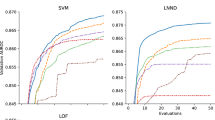Abstract
This paper presents a novel instance-based learning methodology the Binomial-Neighbour (B-N) algorithm. Unlike to other k-Nearest Neighbour algorithms, B-N employs binomial search through vectors of statistical features and distance primitives. The binomial combinations derived from the search with best classification accuracy are distinct primitives which characterise a pattern. The statistical features employ a twofold role; initially to model the data set in a dimensionality reduction preprocessing, and finally to exploit these attributes to recognise patterns. The paper introduces as well a performance measure scheme for multiclass problems using type error statistics. We harness this scheme to evaluate the B-N model on a benchmark human action dataset of normal and aggressive activities. Classification results are being compared with the standard IBk and IB1 models achieving significantly exceptional recognition performance.


Similar content being viewed by others
Notes
The expression \(e_i \ne a_i\) denotes a misclassified instance.
The expression \(e_i = -1\) denotes an out-of-scope misclassified instance (\(e_i \notin C\)).
The original statistical functions derived from performance metrics, which have been used for the multiclass problem, are included in the work of Sokolova et al. (2006).
All primitive abbreviations can be found in the primitive table presented in Theodoridis and Hu (2008).
Fig. 2 Primitive function usage of the B-N representation. a Features, b Distances, c Voronoi diagram. (Primitive abbreviations can be found at Theodoridis and Hu (2008)). Features SUM adder, MAX maximum, MIN minimum, WAMP Willison amplitude, SSC slope sign changes, ZC zero crossing, WL waveform length, EPR error propagation, KUR Kurtosis, SKE skewness, VAR variance, SDV standard deviation, MDR mid-range, MAVS MAV slope, MAV mean absolute value, RMS root mean square, GOM geometric-mean, HRM harmonic mean, GNM generalised mean, IQM interquartile mean, MEAN mean, Distances BHD Bhattacharyya dist., TVD total variation, PDD probability distribution, MCV Pearsons coefficient, MSE mean square error, SQR square error, ABS absolute dist., ERR error difference, LEE Lee dist., BRD Bregman divergence, MNE Mahalanobis Norm., EUC Euclidean dist
References
Aha DW, Kibler D, Albert MK (1991) Instance-based learning algorithms. Mach Learn 6(1):37–66
Alvarez SA (2002) An exact analytical relation among recall, precision and classification accuracy in information retrieval. Technical report, BCCS-02-01, Computer Science Department, Boston College
Asuncion A, Newman DJ (2007) UCI machine learning repository [Online]. Available: http://www.ics.uci.edu/mlearn/MLRepository.html
Cheng W, Hüllermeier E (2009) Combining instance-based learning and logistic regression for multilabel classification. Mach Learn 76(2–3):211–225
Duda RO, Hart PE, Stork DG (2000) Pattern classification. Wiley, New York
Hall M, Frank E, Holmes G, Pfahringer B, Reutemann P, Witten IH (2009) The weka data mining software: an update. SIGKDD Explor Newsl 11(1):10–18
Lee YH, Wei CP, Cheng TH, Yang CT (2012) Nearest-neighbor-based approach to time-series classification. Decis Support Syst 53(1):207–217
Lessmann S (2004) Solving imbalanced classification problems with support vector machines. In: IC-AI, pp 214–220
Li Y, Yang J, Han J (2004) Continuous k-nearest neighbor search for moving objects. Scientific and Statistical Database Management, International Conference on 123
Lughofer E (2011) Evolving fuzzy systems-methodologies, advanced concepts and applications. In: Studies in fuzziness and soft computing, vol 266. Springer, Verlag Berlin Heidelberg, p 456
Makhoul J, Kubala F, Schwartz R, Weischedel R (1999) Performance measures for information extraction. In: Proceedings of DARPA Broadcast News Workshop, pp 249–252
Mitchell TM (1997) Machine learning. McGraw-Hill, Boston Massachusetts
Nasibov EN, Peker S (2011) Time series labeling algorithms based on the k-nearest neighbors’ frequencies. Exp Syst Appl 38(5):5028–5035
Olson DL, Delen D (2008) Advanced data mining techniques. 1. Springer Berlin Heidelberg
Ordez FJ, Iglesias JA, de Toledo P, Ledezma A, Sanchis A (2013) Online activity recognition using evolving classifiers. Exp Syst Appl 40:1248–1255
Peter DT (1994) Theoretical analyses of cross-validation error and voting in instance-based learning. J Exp Theor Artif Intell 6:331–360
Piegl LA, Tiller W (2002) Algorithm for finding all k nearest neighbors. Comput Aided Des 34(2):167–172
Qin MK, Ding Q, Perrizo W (2002) K-nearest neighbor classification on spatial data streams using p-trees. Springer pp 517–528
Rubio JJ, Vzquez DM, Mjica-Vargas D (2013) Acquisition system and approximation of brain signals. IET Sci Meas Technol 7(4):232–239
Rubio G, Herrera LJ, Pomares H, Rojas I, Guillén A (2010) Design of specific-to-problem kernels and use of kernel weighted k-nearest neighbours for time series modelling. Neurocomputing 73(10–12):1965–1975
Sokolova M, Japkowicz N, Szpakowicz S (2006) Beyond accuracy, f-score and roc: A family of discriminant measures for performance evaluation. Adv Artif Intel pp 1015–1021
Theodoridis T, Hu H (2008) A fuzzy-convolution model for physical action and behaviour pattern recognition of 3d time series. In: IEEE International Conference on Robotics and Biomimetics (ROBIO’08), pp 407–412
Theodoridis T, Agapitos A, Hu H, Lucas SM (2008) Ubiquitous robotics in physical human action recognition a comparison between dynamic anns and gp. In: IEEE International Conference on Robotics and Automation (ICRA’08), pp 3064–3069
Theodoridis T, Agapitos A, Hu H, Lucas SM (2009) Mechanical feature attributes for modeling and pattern classification of physical activities. In: IEEE International Conference on Information and Automation (ICIA09), pp 528–533
Vzquez DM, Rubio JJ, Pacheco J (2012) Characterization framework for epileptic signals. IET Image Process 6(9):1227–1235
Author information
Authors and Affiliations
Corresponding author
Additional information
Communicated by V. Loia.
Primitive feature, distance, and statistical vectors (\(\varvec{f}\), \(\varvec{d}\), \(\varvec{z}\)) have been used extensively in this work, taken from the primitive table presented in Theodoridis and Hu (2008).
Rights and permissions
About this article
Cite this article
Theodoridis, T., Hu, H. The binomial-neighbour instance-based learner on a multiclass performance measure scheme. Soft Comput 19, 2973–2981 (2015). https://doi.org/10.1007/s00500-014-1461-z
Published:
Issue Date:
DOI: https://doi.org/10.1007/s00500-014-1461-z





